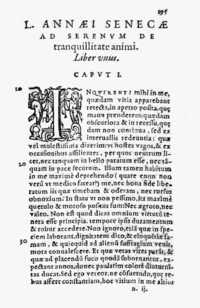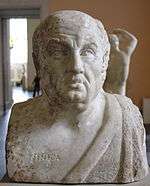De Tranquillitate Animi
De Tranquillitate Animi (On the tranquility of the mind) is a Latin work by the Stoic philosopher Seneca (4 BC–65 AD). The dialogue concerns the state of mind of Seneca's friend Annaeus Serenus, and how to cure Serenus of anxiety, worry and disgust with life.
 From the 1594 edition, published by Jean Le Preux | |
| Author | Lucius Annaeus Seneca |
|---|---|
| Country | Ancient Rome |
| Language | Latin |
| Subject | Ethics |
| Genre | Philosophy |
Publication date | AD c. 60 |
Background
Around 400 B.C., Democritus wrote a treatise On Cheerfulness (Greek: Περι εύθυμίης; Peri euthymiés). The term euthymia, or "cheerfulness", can mean steadiness of the mind, well-being of the soul, self-confidence.[1][2] Seneca lauds Democritus in relation to his treatise on the subject,[3] and states that he will use the Latin word tranquillitas as a rough translation of euthymia.[4]
Writing a little later than Seneca, Plutarch wrote a similar work, described in the 1589 translation as, "a philosophical treatise concerning the quietness of the mind".[5]
Dating
De Tranquillitate Animi is thought to be written during the years 49 to 62 A.D. It has often been dated to around 60 AD on the (possibly wrong) assumption that the theme of the dialogue reflects Seneca's own deteriorating political situation at court.[6]
Title and contents
The title when translated into English means on the tranquility of the mind (or) soul. The word animi is translated, in a general sense, as the rational soul, and in a more restricted sense, as the mind as a thing thinking, feeling, willing. T. M. Green provides definitions of animus, animi as being soul, mind and also courage, passion. Monteleone translated tranquillitas animi as, mental equilibrium.[7][8][9]
De Tranquillitate Animi is part of Seneca's series of Dialogi (dialogues). The dialogue concerns the state of the animi of Seneca's friend Annaeus Serenus, and how to cure Serenus of anxiety, worry and disgust with life.[10][11]
it is more typical of a human to laugh down life than to bewail it
— 15.2 [12]
Seneca finishes De Tranquillitate with a quote by Aristotle:[13][14]
nullum magnum ingenium sine mixtura dementiae fuit
no great genius has existed without a strain of madness
Themes

Seneca, as with other Stoics, was concerned with providing insight for the development of a practice of life, for others to develop into virtuous individuals and to achieve inner harmony.[15] De Tranquillitate Animi is one of a trio of dialogues to his friend Serenus, which includes De Constantia Sapientis and De Otio. The superior position ho sophos (the sage) inhabits, of detachment from earthly (terena) possibilities of future events of a detrimental nature, is the unifying theme of the dialogues.[16][17]
Compared with the other two works, the intention of De Tranquillitate Animi is more therapeutic.[18] The work opens with Serenus asking Seneca for counsel, and this request for help takes the form of a medical consultation. Serenus explains that he feels agitated, and in a state of unstable immobility, "as if I were on a boat that doesn't move forward and is tossed about."[10] Seneca uses the dialogue to address an issue that cropped up many times in his life: the desire for a life of contemplation and the need for active political engagement.[17] Seneca argues that the goal of a tranquil mind can be achieved by being flexible and seeking a middle way between the two extremes.[17]
If we want to achieve peace of mind, Seneca recommends an austere life, oblivious to excessive and useless luxury. He advises us to choose our companions carefully, since if we choose those that are corrupted by the vices, their vices will extend to us (chapter 7). Austerity is the main treatment for peace of mind: we have to learn to know how to contain ourselves, curb our desires, temper gluttony, mitigate anger, to look at poverty with good eyes and to revere self-control (chapter 8). Seneca compares those who have a lot and do not know how to enjoy it to a person who owns a large library of books for mere display (chapter 9).
In chapter 11, Seneca introduces the figure of the Stoic sage, whose peace of mind (ataraxia) springs directly from a greater understanding of the world. The sage's complete security and self-sufficiency exclude the unhealthy passions (apatheia), i.e disturbances which cannot upset the person who is, by definition, rational. Only reasoning, caution, and foresight can create in someone the ideal atmosphere of peace. The philosopher, while preserving his peace of mind, does not hate humanity for its injustice, vileness, stupidity and corruption. The times we live in are no worse than the preceding ones, it is not reasonable to waste time raging about these evils, it is more reasonable to laugh at them (chapter 15).
Thus the right treatment is to follow nature, find the right balance between sociability and solitude, labour and leisure, sobriety and intoxication, and to "watch over our vacillating mind with intense and unremitting care" (chapter 17).
Later history
The first extant copy of the work is as part of the codex Ambrosianus (no. 90), of the Ambrosianus library in Milan, dating from the 11th century A.D.[19][20]
References
- OAW Dilke (edited by Wolfgang Haase) (1981). The Interpretation of Horace's Epistles (in) Aufstieg und niedergang der Römischen welt. Walter de Gruyter. p. 1849. ISBN 3110084678. Retrieved 2015-03-16.
- F Copleston (2003). History of Philosophy Volume 1: Greece and Rome. A&C Black. p. 125. ISBN 0826468950. Retrieved 2015-03-14.
- S McElduff (2013). Roman Theories of Translation: Surpassing the Source. Routledge. ISBN 978-1135069063. Retrieved 2015-03-14.
- GA Kennedy (2008). The Art of Rhetoric in the Roman World: 300 B. C. - A. D. 300. Wipf and Stock Publishers. p. 472. ISBN 978-1556359798. Retrieved 2015-03-16.Volume 2 of History of rhetoric
- catalogue showing - A philosophicall treatise concerning the quietnes of the mind. Taken out of the morall workes written in Greeke, by the most famous philosopher, & historiographer, Plutarch of Cherronea, ... by Iohn Clapham. [London]: Printed by Robert Robinson for Thomas Newman, 1589 (ed. made available online via Digital Library Production Service (DLPS) & Text Creation Partnership) [Retrieved 2015-3-29]
- Fritz-Heiner Mutschler in Brill's Companion to Seneca: Philosopher and Dramatist, pages 153-4 [Retrieved 2015-3-14]
- Perseus Digital Library - Tufts University Search Tools - Latin Word Study Tool (for expanded definitions see page under Lewis & Short) [Retrieved 2015-3-14]
- T. M. Green, The Greek & Latin Roots of English (Rowman & Littlefield, 17 Jul 2014) ISBN 1442233281 [Retrieved 2015-3-14]
- M.Monteleone - Brill's Companion to Seneca: Philosopher and Dramatist (head of p.129) (edited by Andreas Heil, Gregor Damschen) [Retrieved 2015-3-15]
- M.Foucault Wrong-Doing, Truth-Telling: The Function of Avowal in Justice (University of Chicago Press, 4 Jun 2014) ISBN 0226257703 [Retrieved 2014-3-14]
- SENECA AS A MORALIST AND PHILOSOPHER in The National quarterly review -p.18 published 1868 (ed. by E.I. Sears) [Retrieved 2015-3-18]
- C Star - The Empire of the Self: Self-Command and Political Speech in Seneca and Petronius - JHU Press, 7 Sep 2012 ISBN 1421406748 [Retrieved 2015-3-14]
- HJ Norman - Genius and Psychiatry Proc R Soc Med. 1923; 16(Sect Psych): 33–38. [Retrieved 2015-3-15] (ed. Norman was the first source here for the latin quote)
- AL Motto, JR Clark - The Paradox of Genius and Madness: Seneca and his Influence [Retrieved 2015-3-15] (ed. Motto & Clark provided a translation of the Latin, etc)
- Groenendijk, Leendert F. and de Ruyter, Doret J.(2009) 'Learning from Seneca: a Stoic perspective on the art of living and education', Ethics and Education, 4: 1, 81 — 92 DOI: 10.1080/17449640902816277 [Retrieved 2015-3-17] (ed. <inner harmony> c.f. p.82;1st paragraph;last sentence, <virtuous> p.82;2nd paragraph;3rd from last sentence, <practical> - p.82;3rd paragraph;last sentence)
- R Bett - A Companion to Ancient Philosophy - p.531 (edited by Mary Louise Gill, Pierre Pellegrin)[Retrieved 2015-3-19] (ed. Bett was source of term ho sophos)
- Gian Biagio Conte (4 Nov 1999). Latin Literature: A History. Translated by J Solodow. JHU Press. ISBN 0801862531. Retrieved 2015-03-19.
- M. T. Griffin - Seneca on Society: A Guide to De Beneficiis, page 146. Oxford University Press, 14 Mar 2013 ISBN 0199245487 [Retrieved 2014-3-14]
- Reynolds, L. D.; Griffin, M. T.; Fantham, E. (2012). "Annaeus Seneca (2), Lucius". In Hornblower, S.; Spawforth, A.; Eidinow, E. (eds.). The Oxford Classical Dictionary. Oxford University Press. ISBN 978-0199545568.
- Colish, Marcia L. (1985). The Stoic Tradition from Antiquity to the Early Middle Ages. 1. BRILL. ISBN 9004072675.
Further reading
Translations
- Elaine Fantham, Harry M. Hine, James Ker, Gareth D. Williams (2014). Seneca: Hardship and Happiness. University of Chicago Press. ISBN 0226748332
External links

- De Tranquillitate Animi (Latin) (ed. John W. Basore)
